When Gary Kahler (founder of Kahler) began to play guitar in the 60s, he was struck with a wave of ideas. He wanted to take the modern electric guitar to the next level.
Gary Kahler started a company that built guitar hardware for various brands, including Fender and Dimarzio. His company was responsible for creating the classic Fender claw bridge and the standard Fender bridges.
As the Kahler company evolved more and more, the idea of the Kahler tremolo bridge was born. The Kahler tremolo bridge was a massive hit in the 1980s. Almost all major guitar brands used the Kahler tremolo bridge in their models.
Some guitars with Kahler include the G&L Jerry Cantrell model, Kerry King BCR, Fender Stratocaster, and the Gibson Tribal Explorer.
What makes the Kahler tremolo bridge unique is its use of a cylindrical cam. While most bridges rely on the fulcrum-pivot principle, the Kahler bridge depends on a rotating cam.
The Kahler bridge is a floating tremolo system. A floating tremolo system allows you to adjust the guitar’s pitch up or down. This type of tremolo system allows for more creative and easy playing.
The strings are always in constant contact with the saddle on a Kahler bridge. Because there is so little friction, many musicians described the Kahler bridge as incredibly smooth.
In the 90s, the demand for tremolo bridges declined heavily. Gary Kahler decided to shift his business to golf clubs instead. It wasn’t until 2004 that the Kahler company remerged.
The Kahler company reinvented itself. The company came out with many new bridges, including fixed and multi-scale bridges.
Kahler’s willingness to continue creating and experimenting is a testament to their legacy. The Kahler brand is still alive and breathing.
Table of Contents
Why Musicians Both Love & Hate Kahler Tremolo
Kahler bridges have a polarizing effect. There are musicians who swear by Kahler as some of the best bridges, while others absolutely despise Kahler bridges.
The people who love Kahler bridges praise how easy they are to install and adjust. Kahler bridges tend to be easier to tune, unlike other bridges. Tuning one string on a Kahler bridge does not greatly affect the other strings.
Another thing people love about Kahler bridges is how easily you can move the whammy bar. On other bridges, you might feel like you are fighting the bar, but on a Kahler, it’s smooth and painless.
Kahler bridges also allow you to freely adjust the saddle radius and the string spacing, which isn’t as common in other bridges.
The people who hate Kahler bridges complain of tuning instability. Many have had experiences with the strings popping out the rollers. This is mainly due to the locking nut, which is the most flawed part of a Kahler bridge.
Others dislike the tone of Kahler bridges. They also feel like Kahler bridges don’t offer as much sustain as other bridges.
Unfortunately, Kahler bridges have more of a bad reputation than a good one. Though Kahler bridges do have some problems, they also have unique qualities that are absent in most bridges.
Whether a Kahler bridge is a good option or not depends on your preferences and playing style. Do not let the overwhelmingly bad reactions towards Kahler bridges steer you away from trying one out.
Kahler Vs Floyd Rose
Is a Kahler bridge or a Floyd Rose bridge better? This is one of the biggest debates on guitar hardware.
However, most people have a strong positive bias towards Floyd Rose bridges that blinds them from perceiving the full reality. Although Floyd Rose bridges are certainly great, they are inferior to Kahler bridges in some aspects.
Kahler bridges have the upper hand when it comes to flexibility. There are many more adjustments you can make on a Kahler than on a Floyd Rose.
The saddles on a Kahler bridge are 100% adjustable. You can move the saddles forward and backward, up and down, and left and right. These movements adjust the intonation, string height, neck width, and string spacing.
The installation process of a Kahler bridge is effortless compared to the installation of a Floyd Rose.
A Kahler bridge is completely self-contained. The springs come attached to the body of the bridge, so no major modification is required.
With Floyd Rose bridges, there needs to be a hole behind the bridge so the springs will fit in. All guitars that come with Floyd Rose bridges include this extra space.
However, if you attempt to install a Floyd Rose bridge on a guitar that doesn’t have this extra space, it can be a pain to modify the guitar.
The springs of a Kahler bridge are smaller than the springs of a Floyd Rose. There are downsides to this, but it also provides one main advantage.
The smaller springs of the Kahler make the bar easier to operate. You can push the bar any way you like without exerting much force.
The plate of a Floyd Rose bridge makes contact with two studs in the body, which are called “knife edges.”
The knife edges need to be well lubricated for the bridge to work properly. Unfortunately, the knife edges can wear off over time.
Another advantage of the Kahler is that the bridges are only ever made by Kahler. There are other manufacturers that create Floyd Rose bridges, other than Floyd Rose itself.
Therefore, the quality of Kahler bridges tends to stay more consistent than Floyd Rose.
On the other hand, Floyd Rose bridges stay in tune longer than Kahler bridges. The locking nut of a Floyd Rose is also superior to that of a Kahler.
The rollers that are attached to the saddle of the Kahler bridge provide little friction. Even though the lack of friction contributes to the smoothness and ease of use, it also makes the strings more likely to snap.
Fortunately, there is a solution to this problem. Many people suggest installing a Floyd Rose locking nut on a Kahler bridge.
This should allow the Kahler bridge to stay in tune longer and decrease the chances of the strings snapping. Additionally, you can apply melted solder on the ends of the strings to strengthen them.
Guitars with Kahler Bridges
1. G&L Rampage Jerry Cantrell
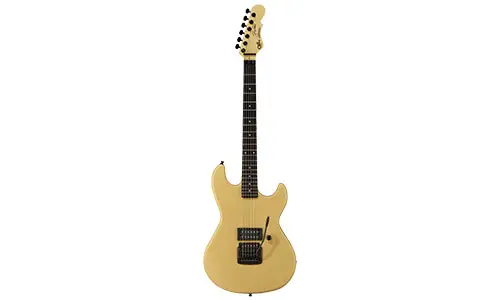
The G&L Rampage Jerry Cantrell guitar is inspired by the lead singer of Alice in Chains. The guitar has all the wonderful qualities of early G&L Rampage guitars, but with additional features.
The guitar features a Soft Maple body, a Hard Rock Maple neck, and an ebony fingerboard. The body finish is ivory and the neck finish is clear satin. It also has 22 medium jumbo frets and a scale of 25 ½ inches.
Best of all, the guitar has a Kahler Hybrid bridge with a Floyd Rose locking nut. You get to have the flexibility of a Kahler bridge with the stability and sustain of a Floyd Rose locking nut.
2. BC Rich Kerry King Signature VBC Rich Kerry King Signature V

The BC Rich Kerry King Signature V is another tribute guitar to a legendary guitarist. Kerry King from the band Slayer had an active role in designing this guitar.
The guitar has the iconic V shape body that Kerry King always loved. The guitar features a maple body with a Canadian Hard Maple neck. It has an ebony fingerboard and abalone tribal inlays.
The guitar includes 24 jumbo frets and a scale of 25 ½ inches. Like the Jerry Cantrell guitar, the Kerry King guitar has a Floyd Rose locking nut with a Kahler X Tremolo bridge.
It has a 1 EMG 81 bridge pickup and a 1 EMG 85 neck humbucker pickup.
3. Charvel Model 2-6
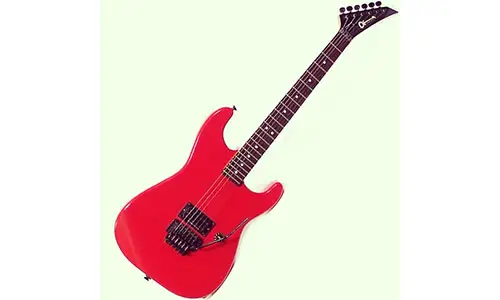
All the Charvel Models from 2 to 6 feature a Kahler bridge. The Charvel Model 2-4 has the Kahler 2520 Traditional Fulcrum Tremolo bridge. Model 5 and 6 feature the Kahler 2300 Pro Vibrato bridge.
Models 2-4 feature a brasswood body, a maple neck, and a rosewood fingerboard. They all have a 25.59-inch scale. However, the pickups for each model are different.
Model 2 only has one pickup at the bridge which is the Jackson J-90C. Model 3 and 4 have a neck pickup, a middle pickup, and a bridge pickup.
Model 3 has the Jackson J-100 pickup at the neck and middle, and the Jackson J-90C at the bridge.
Model 4 features the Jackson J-200 as the neck and middle pickups and the Jackson J-50BC as the bridge pickup.
Model 5 and 6 both have a maple body and a maple neck. They also feature a 25.5-inch scale. Model 5 features the Jackson J-80C pickup at the neck and bridge.
On the other hand, Model 6 features the Jackson J-200 as the neck and middle pickups and the Jackson J-50BC as the bridge pickup.
4. ESP LTD GT-600 & JH-600

Both the ESP GT-600 and the ESP JH-600 feature a Kahler Hybrid bridge. The GT-600 has a mahogany body, a maple neck, and an ebony fingerboard. The JH-600 features the same neck and fingerboard material, but it has an alder body.
The GT-600 is the signature guitar of musician Glenn Tipton, while the JH-600 is the guitar of Jeff Hanneman. The GT-600 is powered by Glenn Tipton’s signature EMG pickups. The JH-600 features the EMG 85 and 81 pickups.
5. Gibson Shred-X Explorer & Tribal Explorer
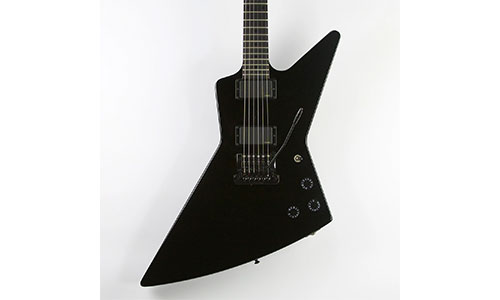
The Gibson Shred-X Explorer and the Gibson Tribal Explorer are some of the newest guitars on this list. While most guitars with Kahler tremolo bridges came out in the 1980s, these two Gibson guitars came out in 2008-2009.
They both feature a mahogany body and neck. They also have a 24 ¾ inch scale and 22 frets. Both Gibson Explorer guitars feature the Kahler 2215 Tremolo system.
The guitar differs the most in their pickups. The Shred-X features an aggressive EMG 85 pickup for both the neck and bridge. The Tribal Explorer features a 496R pickup for the neck and a 500T pickup for the bridge.
6. Jackson KE-1 Marty Friedman
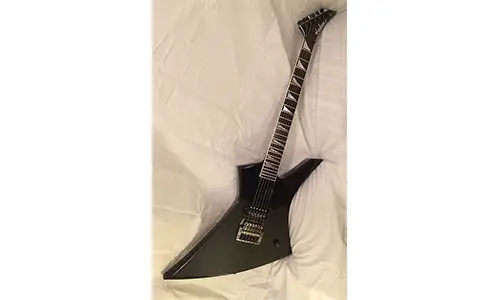
The Jackson KE-1 is a rare guitar from 1998 that comes with the Kahler AMP3310 bridge. The guitar is inspired by the lead guitarist of the band Megadeth.
The body is constructed of poplar, while the neck is made of Quarter Sawn Maple. The guitar has a standard scale length of 25.5 inches and 24 frets. The KE-1 has a Seymour Duncan TB-4 bridge pickup.
7. Peavey PXD Twenty-Three III & Void III
Both the Peavey Twenty-Three III and the Peavey Void III have a mahogany body and neck with a rosewood fingerboard. They also have a Kahler Tremolo system.
They both have a 24-¾ inch scale with 24 frets. Both guitars have EMG pickups at the neck and bridge. The only significant difference between these two guitars is their body shape.
The Peavey Twenty-Three III has a classic soloist shape, while the Peavey Void III has a bold firebird shape.
8. Carvin V220 Guitar
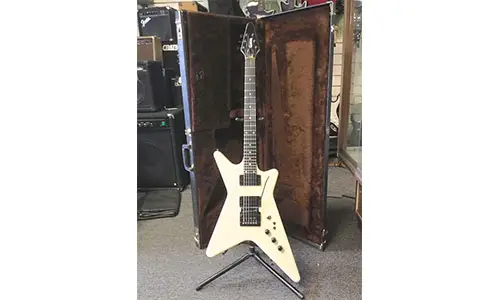
The Carvin V220 is an 80s guitar with a Kahler Tremolo bridge. The guitar features an alder body and a maple neck. It has an ebony fingerboard with pearloid dot inlays.
The V220 features 24 frets and a scale length of 24 ¾ inches. The guitar has two humbucker pickups. The one at the neck is a Gibson pickup, while the one at the bridge is a Quad Rail pickup.
9. 1988 MIJ Fender Stratocaster
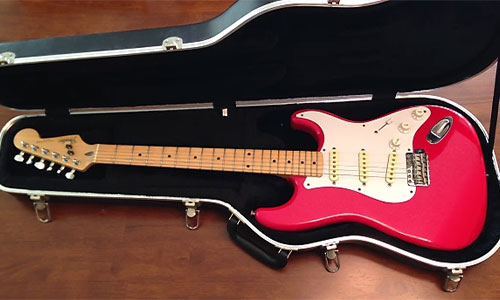
This Fender Stratocaster from 1988 features the rare Kahler Spyder bridge. It also features an alder body and a maple neck and fingerboard.
The guitar was made at the Fuji-gen factory in Japan like many other Stratocasters in the 80s. This was mainly due to the low domestic output that Fender was facing at the time. They were forced to rely on Japanese imports.
Fortunately, most of the Stratocasters produced in Japan are of excellent quality. The majority are iconic Stratocaster models, most of which feature Kahler bridges.
10. G&L Invader 1985
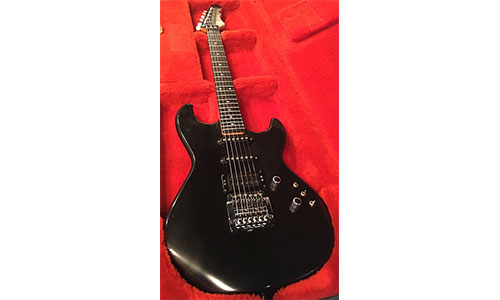
The G&L Invader from 1985 comes equipped with the Kahler 2300 bridge. The guitar features a poplar body with a double cutaway.
It also has a bolt-on maple neck. Most of the guitars come with either a maple fingerboard or a rosewood fingerboard.
The guitar has a standard 25.5-inch scale and 22 frets. The Invader features two single coil pickups and one humbucker pickup.
The Invader is often compared with the G&L Rampage models, which have similar features. The G&L Rampage differs from the Invader in terms of electronics.
The G&L Invader was famously played by musician D’Angelo.
11. 80s Peavey Tracer
The Peavey Tracer from the 80s features the Kahler Spyder Vibrator bridge. It has a poplar body and a bolt-on maple neck.
The Tracer features a rosewood fingerboard and 24 medium frets. It has three different sets of pickups.
The neck pickup is a Seymour Duncan pickup, the middle pickup is a single coil pickup, and the bridge pickup is a humbucker pickup.
12. Carvin DC200 Koa
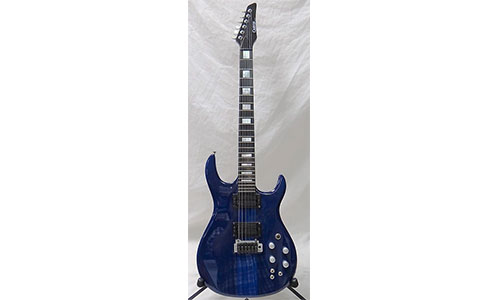
The Carvin DC200 features an extremely rare Kahler locking tremolo system. Both the body and the neck are made of Hawaiian koa.
It has an ebony fingerboard with pearl block inlays. The DC200 has 24 frets and Schaller M6 tuners. It also features two Carvin M22 pickups.
13. Dean V SEL 24 K & ML SEL 24 K
Both the Dean V SEL 24 K and the Dean ML SEL 24 K feature the classic Kahler Hybrid Tremolo.
The body and neck of the guitars are made of eastern mahogany. The necks of the guitars have a satin design with an ebony fingerboard.
Both guitars feature the same pickups: Seymour Duncan TB5 and Seymour Duncan APH-1.
The guitars differ in their body shapes. The V SEL has a V body shape, while the ML SEL has an ML shape. Both guitars came out in the past year.
14. Dean MD24 K
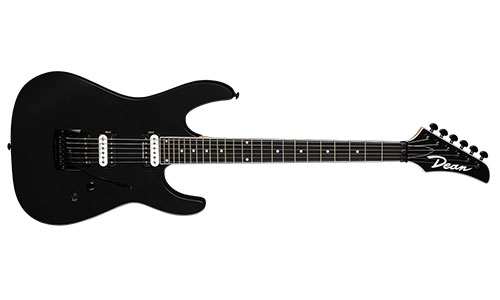
Like the Dean SEL models, the Dean MD24 also features the classic Kahler Hybrid Tremolo. The guitar has a brasswood body and a 24-fret ebony fingerboard.
The MD24 features a comfortable 3-piece maple neck. The neck is a slim C shape, while the body is an MD shape. The pickups on the guitar are the Seymour Duncan APH-1 and the TB5.
15. Dean Multiscale Exile 6
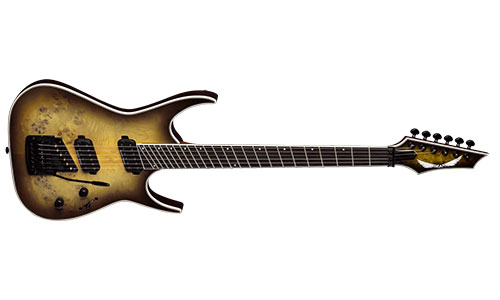
The Exile 6 is one of the best Dean guitars with a Kahler bridge. During the process of creating the Exile 6, Dean teamed up with Kahler to design a multiscale bridge.
The guitar features a Kahler Tremolo system for multiscale guitars. The Exile 6 has an alder body and a 3-piece maple neck.
It has 24 jumbo frets and a 16-inch ebony fingerboard. The Exile 6 features the Seymour Duncan Angled Nazgul pickup for the neck and the Seymour Duncan Angled Sentient for the bridge.
Overview of Kahler Bridges
Kahler designs bridges for guitars and basses. The types of bridges available for guitars are tremolo, multiscale, and fixed bridges.
Kahler also offers stud-mounted bridges and flat-mounted bridges for 6-string through 10-string guitars.
Tremolo:
Tremolo bridges are undoubtedly the most popular type of Kahler bridge. Tremolo bridges are also known as “vibrato bridges.” Tremolo bridges give players direct control over the pitch of the strings.
Kahler’s most popular tremolo bridges are in their 2300 series. The bridges on their 2300 series are everything you would expect from Kahler- easy to install and use.
You can also lock the tremolo bridge into a fixed bridge, so you have two in one. The 2200 Series also offers excellent bridges, which are ideal for Les Paul guitars. Kahler’s 2400 Series provides the most saddle options.
You are free to choose from forward saddles and rearward saddles, which are unique to the 2400 Series.
The 2440 Series offers the most adjustable bridges. You can adjust the saddle in six different ways and change the string spacing.
Multiscale:
Multiscale bridges are for multiscale guitars- makes sense, right? Multiscale guitars are guitars where every string has its own individual scale length.
Multiscale guitars are more comfortable to play and provide a broader range of tones. Kahler offers about 24 options of multiscale bridges.
There are a few multiscale bridges available in Kahler’s 2300 Series. The rest are part of their 2230, 2340, and 2350 collections.
Kahler’s multiscale bridges provide similar features to their regular tremolo bridges. The only real difference is the multiscale aspect of the bridges.
Fixed:
Fixed bridges, also known as “hardtail bridges,” are the simplest type of bridges. The bridge is screwed to the body of the guitar and requires very little maintenance.
Fixed bridges are known for their incredible tuning stability, which is why they are the go-to option for many players.
Kahler offers 18 fixed bridges from three different series. The 7330 Series provides Kahler’s most popular fixed bridges, which are extremely practical and affordable.
The Quad Series is more adjustable and customizable. You have a variety of color finish options to choose from. The Quad Series also provides a larger range of bridge options.
Kahler’s 3300 Series only provides flat-mount bridges for 6-string guitars. The bridges in this series cost about the same as the 7330 bridges.
Final Words
Despite the bad rap that Kahler bridges get, they have undoubtedly shaped the guitar hardware industry. They have provided the opportunity to reinvent the design of bridges.
Even though many people do not believe the Kahler bridge design is effective, Kahler still left a mark on the hardware industry.
Kahler bridges were used in many iconic guitar models from the 80s. The 80s guitar models proved the potential of Kahler bridges.
They were definitely not everyone’s cup of tea, but the people who appreciated Kahler bridges understood their function the most.
Most problems people experience with Kahler bridges are caused by a misunderstanding of their intent and proper setup.
Kahler bridges can work phenomenally if set up correctly and adjusted. As mentioned previously, installing a Floyd Rose locking nut is a great way to solve Kahler’s tuning stability issue.
Whether you should invest in a Floyd Rose or a Kahler depends on your personal preferences.
Both bridges have their issues and their advantages. It’s a question of what you value most in a bridge and what you are willing to put up with.


![Kaotica Eyeball vs Fatboy: ALL You Need to Know [2023]](https://performerlife.com/wp-content/uploads/2022/05/Kaotica-fatboy-211x150.jpg)

![What Happened To “Chief Keef”? [Everything to Know About This Rapper]](https://performerlife.com/wp-content/uploads/2022/05/Chief-Keef-211x150.jpg)